

This ancient mnemonic technique builds a palace of memory. A lukasa memory board.
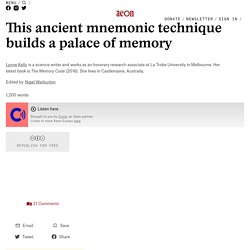
Courtesy Brooklyn Museum/Wikimedia In Arthur Conan Doyle’s detective novel A Study in Scarlet (1887) we learn that Sherlock Holmes used the most effective memory system known: a memory palace. Although imagined memory palaces are still used by memory champions and the few who practice the memory arts, they are best known from Greco-Roman times when great orators, including Cicero, used them to ensure their rhetoric was smooth, detailed and flawless. Monument to Indigenous Women Will Replace Columbus Statue in Mexico City. A pedestal in the center of Mexico City that once hosted a statue of Christopher Columbus has stood empty since last October.
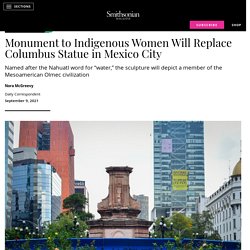
Now, reports Johnny Diaz for the New York Times, a sculpture of an Indigenous woman is set to replace the controversial explorer’s likeness. Mayor Claudia Sheinbaum announced plans for the new statue last Sunday, on Mexico’s Day of the Indigenous Woman. Designed by Mexican sculptor Pedro Reyes, the soon-to-be installed statue is titled Tlalli—the Nahuatl word for water. Indigenous warrior women take fight to save ancestral lands to Brazilian capital. More than 5,000 indigenous women have marched through Brazil’s capital to denounce the historic assault on native lands they say is unfolding under the country’s far-right president, Jair Bolsonaro.

Female representatives of more than 170 of Brazil’s 300-plus tribes have gathered in Brasília in recent days to oppose highly controversial attempts to strip back indigenous land rights and open their territories to mining operations and agribusiness. Indigenous People of Siberia Photographed for 'The World in Faces'. Ulchi Woman. Ulchsky District, Khabarovsk Krai, Far East, Siberia. © Alexander Khimushin / The World In Faces For the past 9 years, photographer Alexander Khimushin has been traveling the world, visiting 84 different countries.
Indigenous peoples - in pictures 2 clicks. Survival International, the global movement for tribal peoples’ rights, has held its first photographic competition to mark its 45th anniversary.
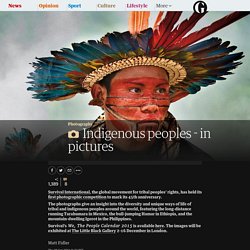
Sami - Northern Scandanavia. People Mongolia. South Pacific. Africa. ASIA. Middle East. South America. There’s a Global Plan to Conserve Nature. Indigenous People Could Lead the Way. With a million species at risk of extinction, dozens of countries are pushing to protect at least 30 percent of the planet’s land and water by 2030.
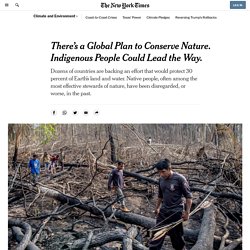
Their goal is to hammer out a global agreement at negotiations to be held in China later this year, designed to keep intact natural areas like old growth forests and wetlands that nurture biodiversity, store carbon and filter water. But many people who have been protecting nature successfully for generations won’t be deciding on the deal: Indigenous communities and others who have kept room for animals, plants and their habitats, not by fencing off nature, but by making a small living from it. The key to their success, research shows, is not extracting too much. 9/17/17: US Sec of Interior advises reduced acreage & protection for national monuments.
A Visual Ethnography of the World’s Last Nomadic Peoples 2 clicks. By Maria Popova What is it about Dutch photographers that makes them so visually eloquent at capturing the human condition?
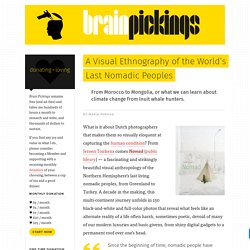
From Jeroen Toirkens comes Nomad (public library) — a fascinating and strikingly beautiful visual anthropology of the Northern Hemisphere’s last living nomadic peoples, from Greenland to Turkey. A decade in the making, this multi-continent journey unfolds in 150 black-and-white and full-color photos that reveal what feels like an alternate reality of a life often harsh, sometimes poetic, devoid of many of our modern luxuries and basic givens, from shiny digital gadgets to a permanent roof over one’s head. Since the beginning of time, nomadic people have roamed the earth. Looking for food, feeding their cattle. How Cultural Anthropologists Redefined Humanity. Not that long ago, Margaret Mead was one of the most widely known intellectuals in America.
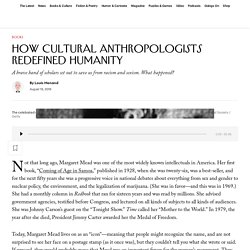
Her first book, “Coming of Age in Samoa,” published in 1928, when she was twenty-six, was a best-seller, and for the next fifty years she was a progressive voice in national debates about everything from sex and gender to nuclear policy, the environment, and the legalization of marijuana. (She was in favor—and this was in 1969.) She had a monthly column in Redbook that ran for sixteen years and was read by millions. She advised government agencies, testified before Congress, and lectured on all kinds of subjects to all kinds of audiences.
Iwgia. org human rights group for indigenous people. Canada’s Supreme Court says Native American Richard Desautel has right to hunt in Canada. The ruling in the case of Richard Desautel, a U.S. citizen and member of the Lakes tribe of the Colville Confederated Tribes in Washington state, ended a legal battle that began in 2010 when he shot a cow elk in the Arrow Lakes region of British Columbia.
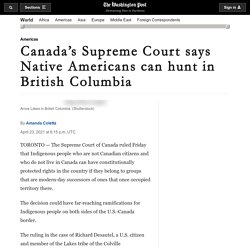
Story continues below advertisement He alerted a conservation officer and was charged with hunting without a license and hunting big game while not a resident of British Columbia. He intended his action to be a test case. Desautel argued that he was exercising his right under Section 35 of Canada’s Constitution Act, which recognizes and affirms rights afforded to “aboriginal peoples of Canada.” He said he had a right to hunt for ceremonial purposes on the traditional territory of his ancestors, the Sinixt, whose ancestral lands extended into what is now British Columbia and whom Canada declared “extinct” many decades ago. A trial court in British Columbia agreed and acquitted him. Survival International - The movement for tribal peoples.
The Greeks really do have near-mythical origins, ancient DNA reveals. Ever since the days of Homer, Greeks have long idealized their Mycenaean “ancestors” in epic poems and classic tragedies that glorify the exploits of Odysseus, King Agamemnon, and other heroes who went in and out of favor with the Greek gods.
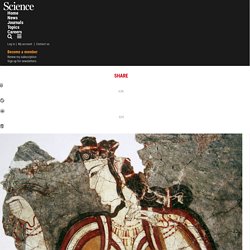
Although these Mycenaeans were fictitious, scholars have debated whether today’s Greeks descend from the actual Mycenaeans, who created a famous civilization that dominated mainland Greece and the Aegean Sea from about 1600 B.C.E. to 1200 B.C.E., or whether the ancient Mycenaeans simply vanished from the region. Now, ancient DNA suggests that living Greeks are indeed the descendants of Mycenaeans, with only a small proportion of DNA from later migrations to Greece. Irish town builds memorial to thank Native Americans who helped during Famine. A sculpture of nine eagle feathers will be installed in Bailic Park, in Midleton, Co Cork to thank the Choctaw Indians for their kindness and support during the Great Irish Famine.
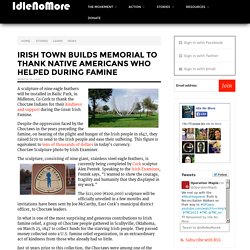
Despite the oppression faced by the Choctaws in the years preceding the famine, on hearing of the plight and hunger of the Irish people in 1847, they raised $170 to send to the Irish people and ease their suffering. This figure is equivalent to tens of thousands of dollars in today’s currency. Choctaw Sculpture photo by Irish Examiner. Indigenous languages must feature more in science communication. There is no denying that English is one of the world’s major languages. It’s the mother tongue of nearly 370 million people. English is also very frequently used by scientists in academic journals and book chapters, along with other common languages like French, Spanish and Portuguese.
But what about the billions of people who speak very little English, or none at all? How can we improve their access to scientific information and knowledge? Whistled language of the island of La Gomera (Canary Islands), the Silbo Gomero. The Last Speakers of the Lost Whistling Language, Sylbo. Indigenous Peoples. Anthropology. Masterpieces of the Oral and Intangible Heritage of Humanity. Survival International - The movement for tribal peoples. Top 10 Navajo Swear Words. Star Wars (translated in Navajo) short excerpt. Skara Brae Scotland 3k B.C. 2 clicks please. History can a bit dry and boring at times. It seems to exist solely between the musty pages of old books.
But once in awhile, you come across a bit of history that appears to come alive the moment you discover it. That’s how I felt when I heard about this place. In a small bay in Scotland, a well-kept secret is hidden among the green hills. At first glance, it might not seem particularly impressive, but step inside and you’ll be amazed at what you see. HOW TO ... LOVE ALL THE THINGS CLIMATE CAN'T CHANGE Doc. Indigenous. Indigenous peoples. Cultures. List of indigenous peoples. Genocide of indigenous peoples. Genocide of indigenous peoples is the genocidal destruction of indigenous peoples, understood as ethnic minorities whose territory has been occupied by colonial expansion or the formation of a nation state,[Note 1] by a dominant political group such as a colonial power or a nation state.
While the concept of genocide was formulated by Raphael Lemkin in the mid-20th century, acts of genocidal violence against indigenous groups frequently occurred in the Americas, Australia, Africa and Asia with the expansion of various European colonial powers such as the Spanish and British empires, and the subsequent establishment of nation states on indigenous territory. According to Lemkin, colonization was in itself "intrinsically genocidal".